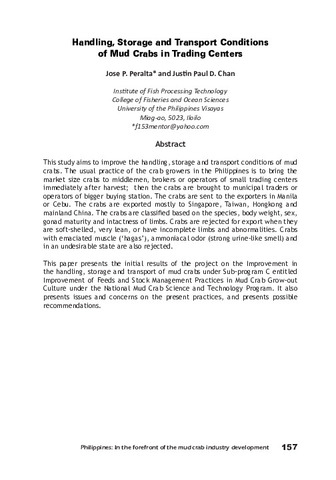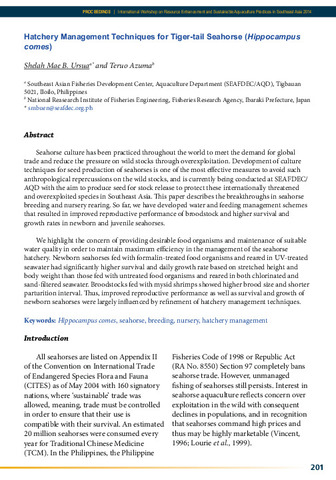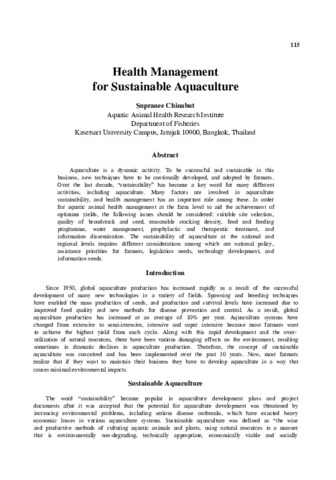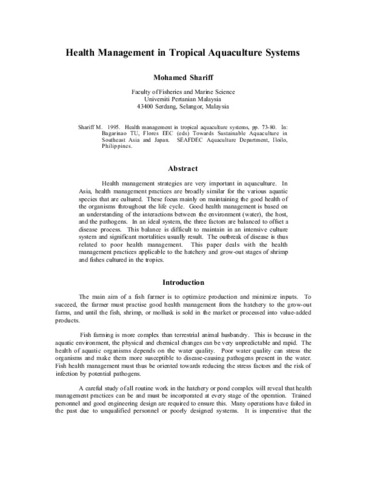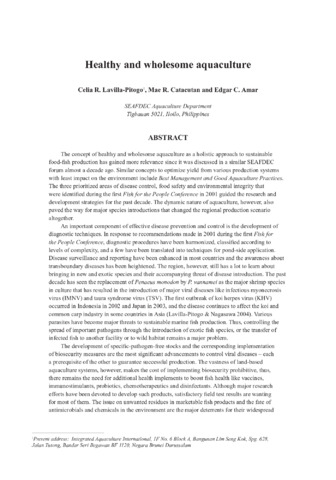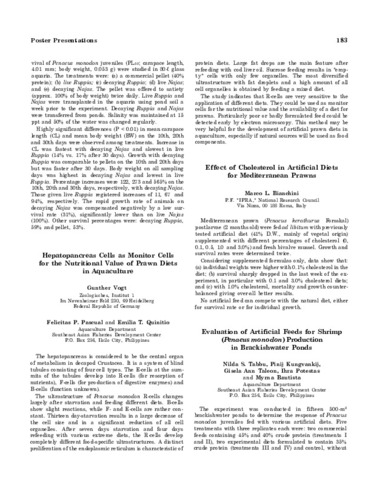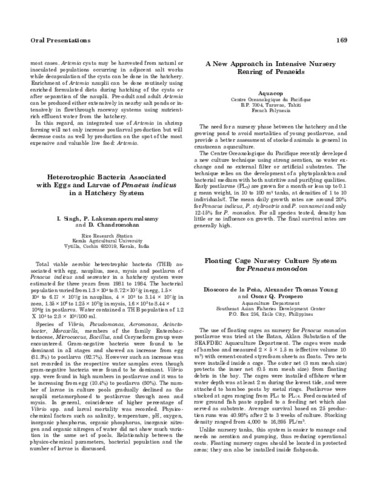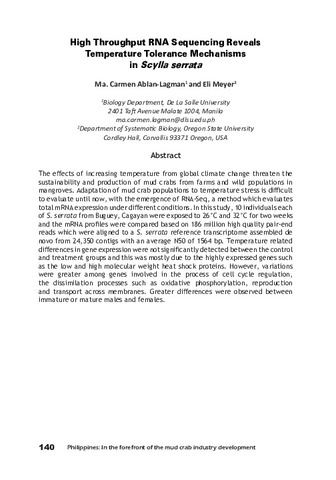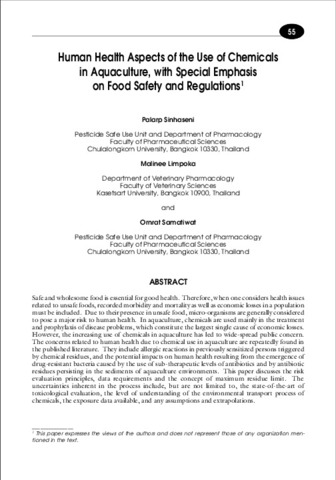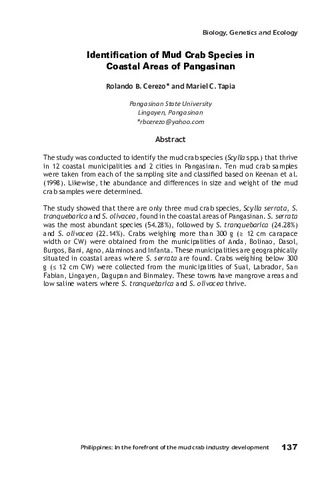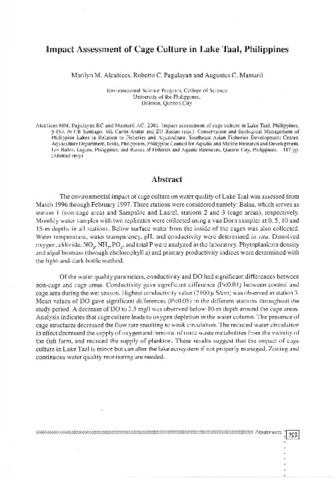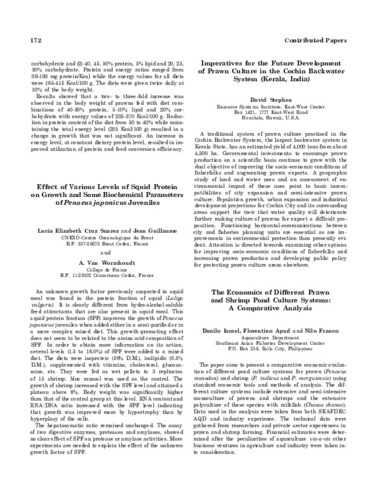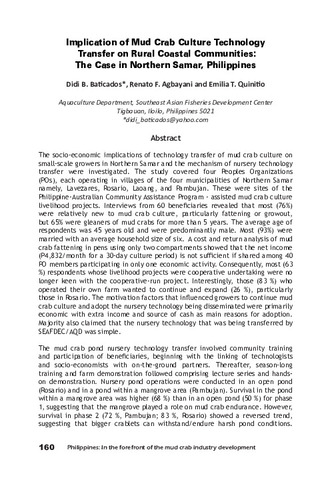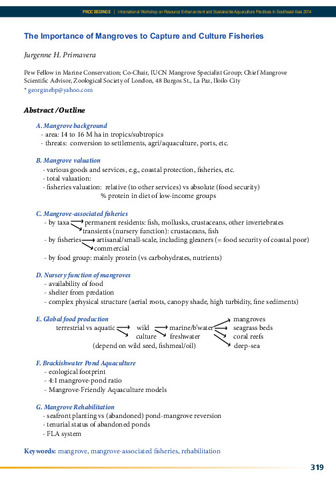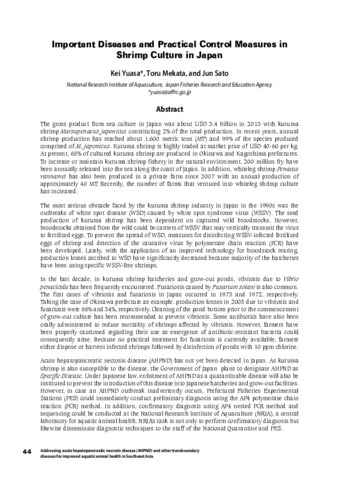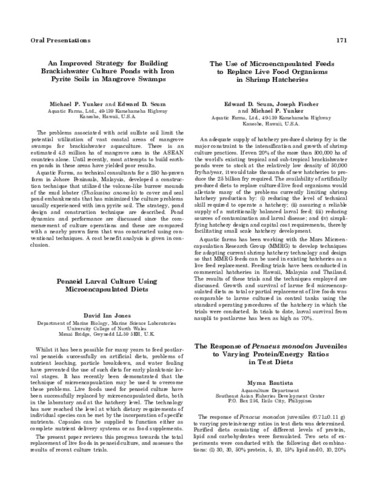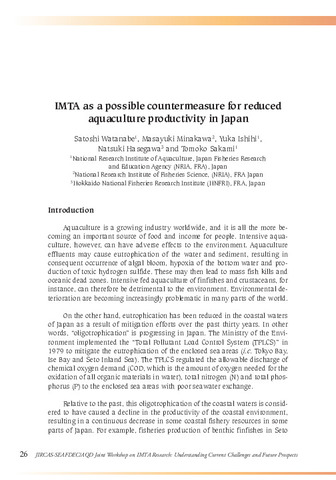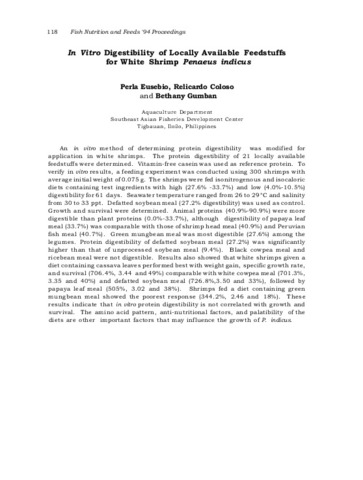Browsing Conference Proceedings by Title
Now showing items 299-318 of 767
-
Handling, storage and transport conditions of mud crabs in trading centers
(Aquaculture Department, Southeast Asian Fisheries Development Center, 2017)This study aims to improve the handling, storage and transport conditions of mud crabs. The usual practice of the crab growers in the Philippines is to bring the market size crabs to middlemen, brokers or operators of small ... -
Hatchery management techniques for tiger-tail seahorse (Hippocampus comes)
(Aquaculture Department, Southeast Asian Fisheries Development Center, 2015)Seahorse culture has been practiced throughout the world to meet the demand for global trade and reduce the pressure on wild stocks through overexploitation. Development of culture techniques for seed production of seahorses ... -
Health management for sustainable aquaculture
(Aquaculture Department, Southeast Asian Fisheries Development Center, 2001)Aquaculture is a dynamic activity. To be successful and sustainable in this business, new techniques have to be continually developed, and adopted by farmers. Over the last decade, sustainability has become a key word ... -
Health management in tropical aquaculture systems
(Aquaculture Department, Southeast Asian Fisheries Development Center, 1995)Health management strategies are very important in aquaculture. In Asia, health management practices are broadly similar for the various aquatic species that are cultured. These focus mainly on maintaining the good health ... -
Healthy and wholesome aquaculture.
(Aquaculture Department, Southeast Asian Fisheries Development Center, 2011)The concept of healthy and wholesome aquaculture as a holistic approach to sustainable food-fish production has gained more relevance since it was discussed in a similar SEAFDEC forum almost a decade ago. Similar concepts ... -
Hepatopancreas cells as monitor cells for the nutritional value of prawn diets in aquaculture
(Aquaculture Department, Southeast Asian Fisheries Development Center, 1985)The hepatopancreas is considered to be the central organ of metabolism in decapod Crustacea. It is a system of blind tubules consisting of four cell types. The E-cells at the summits of the tubules develop into R-cells ... -
Heterotrophic bacteria associated with eggs and larvae of Penaeus indicus in a hatchery system
(Aquaculture Department, Southeast Asian Fisheries Development Center, 1985)Total viable aerobic heterotrophic bacteria (THB) associated with egg, nauplius, zoea, mysis and postlarva of Penaeus indicus and seawater in a hatchery system were estimated for three years from 1981 to 1984. The bacterial ... -
High throughput RNA sequencing reveals temperature tolerance mechanisms in Scylla serrata
(Aquaculture Department, Southeast Asian Fisheries Development Center, 2017)The effects of increasing temperature from global climate change threaten the sustainability and production of mud crabs from farms and wild populations in mangroves. Adaptation of mud crab populations to temperature stress ... -
Human health aspects of the use of chemicals in aquaculture, with special emphasis on food safety and regulations
(Aquaculture Department, Southeast Asian Fisheries Development Center, 2000)Safe and wholesome food is essential for good health. Therefore, when one considers health issues related to unsafe foods, recorded morbidity and mortality as well as economic losses in a population must be included. Due ... -
Identification of mud crab species in coastal areas of Pangasinan
(Aquaculture Department, Southeast Asian Fisheries Development Center, 2017)The study was conducted to identify the mud crab species (Scylla spp.) that thrive in 12 coastal municipalities and 2 cities in Pangasinan. Ten mud crab samples were taken from each of the sampling site and classified based ... -
Impact assessment of cage culture in Lake Taal, Philippines
(Aquaculture Department, Southeast Asian Fisheries Development Center; Philippine Council for Aquatic and Marine Research and Development (PCAMRD), Department of Science and Technology; Bureau of Fisheries and Aquatic Resources, 2001)The environmental impact of cage culture on water quality of Lake Taal was assessed from March 1996 through February 1997. Three stations were considered namely: Balas, which serves as station 1 (non-cage area) and Sampaloc ... -
Impact of nickel poisoning on the histology of the ovaries of Oreochromis mossambicus
(Aquaculture Department, Southeast Asian Fisheries Development Center, 1996)Ovaries of Oreochromis mossambicus exposed to sublethal concentrations of nickel sulphate (0.5 mg/1 and 1.0 mg/1) were histologically analyzed. Changes following exposure to 0.5 mg/1 nickel sulphate include irregularities ... -
Imperatives for the future development of prawn culture in the Cochin backwater system (Kerala, India)
(Aquaculture Department, Southeast Asian Fisheries Development Center, 1985)A traditional system of prawn culture practised in the Cochin Backwater System, the largest backwater system in Kerala State, has an estimated yield of 4,000 tons from about 4,500 ha. Governmental investments to encourage ... -
Implication of mud crab culture technology transfer on rural coastal communities: The case in northern Samar, Philippines
(Aquaculture Department, Southeast Asian Fisheries Development Center, 2017)The socio-economic implications of technology transfer of mud crab culture on small-scale growers in Northern Samar and the mechanism of nursery technology transfer were investigated. The study covered four Peoples ... -
The importance of mangroves to capture and culture fisheries
(Aquaculture Department, Southeast Asian Fisheries Development Center, 2015)Abstract only. -
Important diseases and practical control measures in shrimp culture in Japan
(Aquaculture Department, Southeast Asian Fisheries Development Center, 2016)The gross product from sea culture in Japan was about USD 3.4 billion in 2013 with kuruma shrimp Marsupenaeus japonicus constituting 2% of the total production. In recent years, annual shrimp production has reached about ... -
An improved strategy for building brackishwater culture ponds with iron pyrite soils in mangrove swamps
(Aquaculture Department, Southeast Asian Fisheries Development Center, 1985)The problems associated with acid sulfate soil limit the potential utilization of vast coastal areas of mangrove swamps for brackishwater aquaculture. There is an estimated 4.8 million ha of mangrove area in the ASEAN ... -
IMTA as a possible countermeasure for reduced aquaculture productivity in Japan
(Aquaculture Department, Southeast Asian Fisheries Development Center; Japan International Research Center for Agricultural Sciences, 2022-07) -
In vitro digestibility of locally available feedstuffs for white shrimp Penaeus indicus
(Aquaculture Department, Southeast Asian Fisheries Development Center, 1996)An in vitro method of determining protein digestibility was modified for application in white shrimps. The protein digestibility of 21 locally available feedstuffs were determined. Vitamin-free casein was used as reference ...


